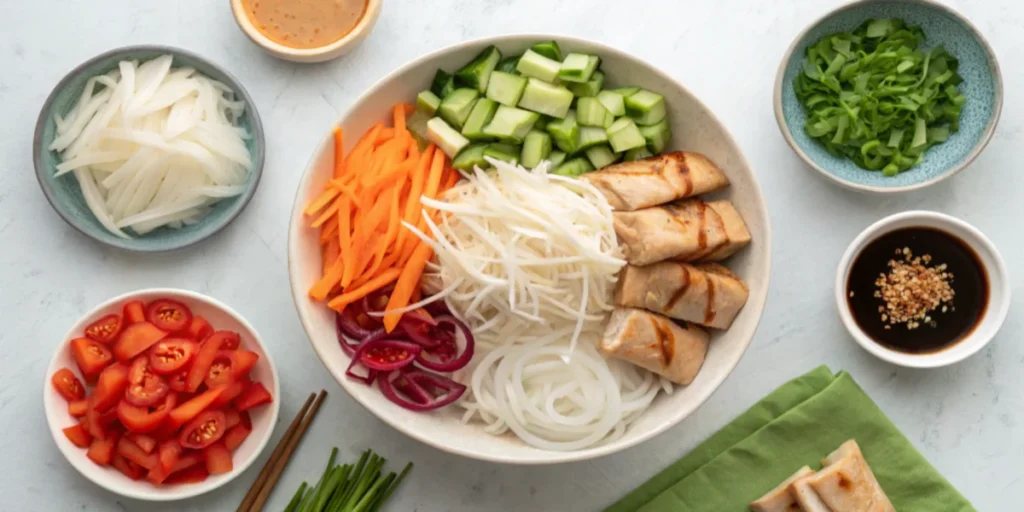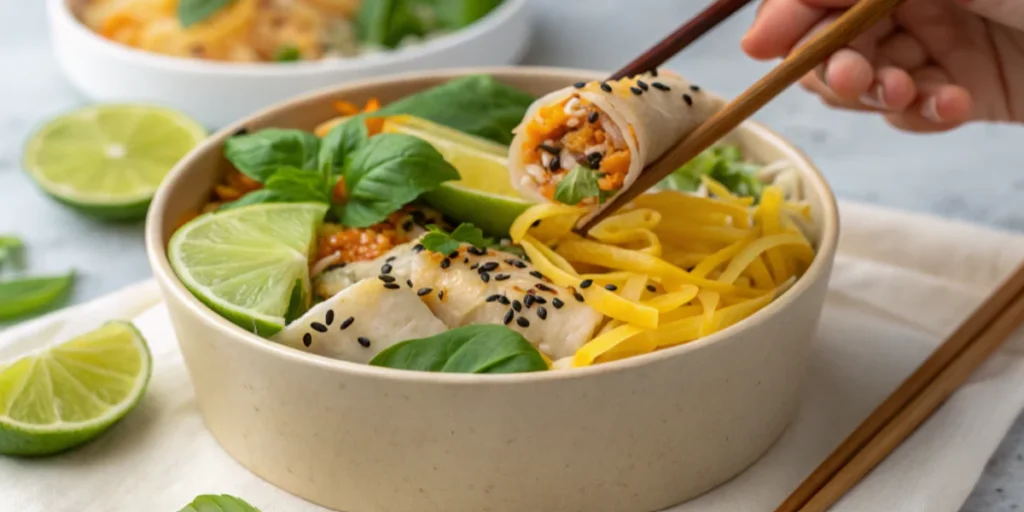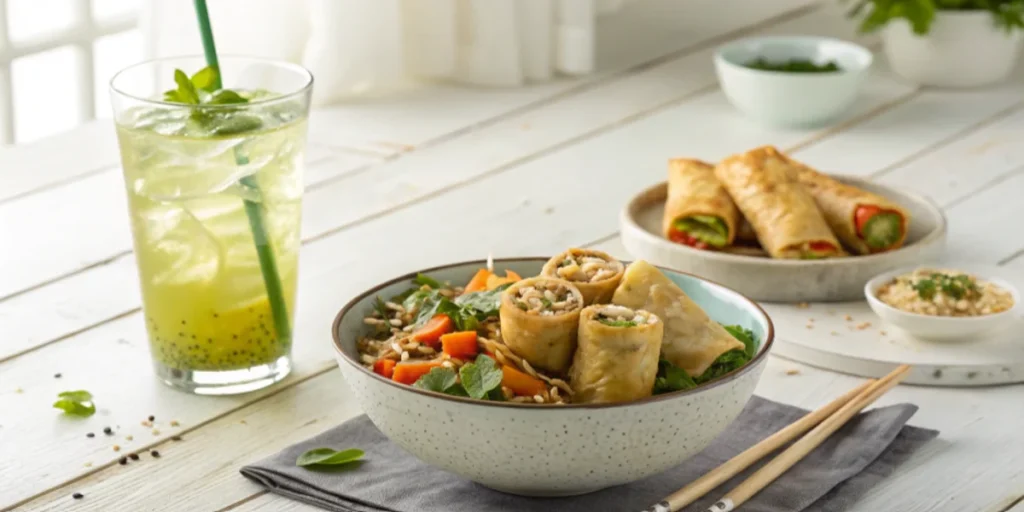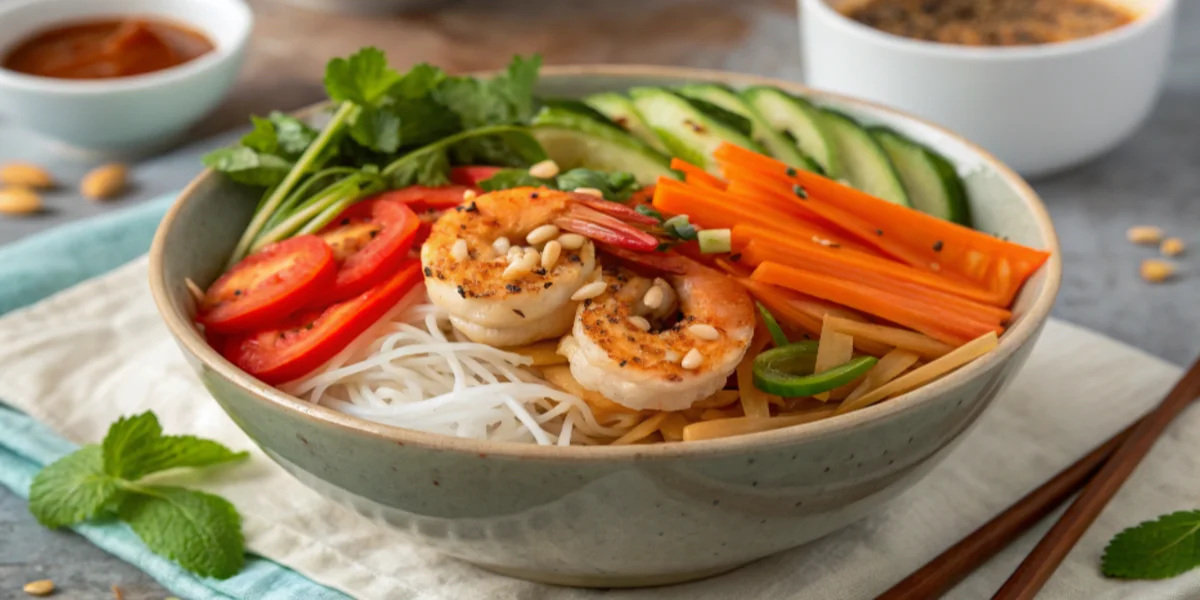Introduction
Okay, let’s be real—sometimes you crave something light, fresh, and packed with flavor, but also super easy to throw together. Enter the spring roll bowl, your new favorite meal that checks all the boxes. Imagine all the goodness of a classic spring roll—crunchy veggies, tender noodles, savory protein, and that oh-so-addictive sauce—but without the hassle of wrapping or rolling. Yep, no tearing rice paper here!
Spring roll bowls are like the laid-back cousin of traditional spring rolls. They’re customizable, healthy, and ridiculously easy to prep. Whether you’re whipping one up for a quick lunch or meal-prepping for the week, this dish will make you feel like a kitchen superstar without breaking a sweat.
What Is a Spring Roll Bowl?
The Basics: What Goes Into a Spring Roll Bowl?
At its heart, a spring roll bowl is a deconstructed version of the traditional Vietnamese spring roll. Think rice noodles, fresh veggies, your choice of protein, and a killer sauce—all layered into a bowl instead of rolled into rice paper. You can mix and match ingredients to your heart’s content, making it as simple or fancy as you want.
A typical bowl might include:
- Base: Rice noodles or greens (or both if you’re feeling wild).
- Veggies: Julienne-cut carrots, cucumbers, bell peppers, and lettuce.
- Protein: Shrimp, chicken, tofu, or plant-based alternatives.
- Sauce: Peanut sauce, sweet chili, or soy-based dressings.
Explore more about balancing flavors and textures by checking out these perfect pairings for lobster tail dishes, which can inspire unique combinations for your spring roll bowl.
How Spring Roll Bowls Differ From Traditional Spring Rolls
Unlike spring rolls that require careful wrapping, these bowls are all about layering. They’re less fussy, more forgiving, and perfect for when you just don’t have the patience for assembly. Plus, you can easily scale up the ingredients for meal prep or family-style serving. The only rule? Keep it fresh, colorful, and balanced.
How to Build the Perfect Spring Roll Bowl

Choosing the Right Base: Rice Noodles, Greens, or Both?
Start with the base of your bowl. Rice noodles give you that chewy, satisfying bite, while greens (like lettuce or mixed greens) add crunch and keep things light. Can’t decide? Combine them for the best of both worlds. Pro tip: If you’re watching carbs, spiralized zucchini or cauliflower rice can step in as lower-carb options.
Adding Fresh Veggies: Top Picks for Crunch and Color
This is where your bowl comes to life. Go for a mix of textures and vibrant colors:
- Crunchy: Julienned carrots, shredded cabbage, or bean sprouts.
- Juicy: Thinly sliced cucumbers and bell peppers.
- Herbaceous: Fresh cilantro, mint, or Thai basil.
Protein Options: Tofu, Shrimp, Chicken, or Plant-Based Substitutes
Protein ties it all together. Grilled shrimp adds a smoky sweetness, while marinated tofu keeps it plant-based. Chicken breast works if you’re leaning toward something hearty. If you’re plant-based, try edamame or tempeh—it’s just as satisfying.
The Sauce: Peanut Sauce, Sweet Chili, or Something New
Let’s be honest: the sauce can make or break your bowl. A creamy peanut sauce is the go-to for its nutty, savory goodness, but don’t overlook sweet chili sauce or a tangy lime-soy vinaigrette. Want to experiment? Mix sriracha, hoisin, and a squeeze of lime for a quick DIY sauce.
For additional ideas on healthy alternatives, explore this guide on eating cookies every day, which offers creative tips on mindful eating.
Why Spring Roll Bowls Are Perfect for Meal Prep
Prepping Ingredients Ahead of Time
Here’s the thing: a spring roll bowl is as easy as it gets for meal prep. Chop your veggies, cook your protein, and store everything separately in airtight containers. That way, when hunger strikes, all you have to do is assemble. (Bonus: no soggy noodles or wilty greens!)
Assembly Tips for Busy Days
Layering is key when you’re short on time. Start with the base, add veggies, top with protein, and keep the sauce on the side until you’re ready to eat. If you’re packing it for lunch, grab a mason jar—it’s portable, mess-free, and kind of Instagram-worthy.
Tips and Tricks for Customizing Your Bowl

Making It Vegan or Vegetarian
Certainly, spring roll bowls appeal to plant-based eaters. Specifically, swap out animal proteins for marinated tofu, crispy tempeh, or a generous scoop of edamame. Moreover, roast your tofu with soy sauce and sesame oil for a slightly smoky bite. Likewise, toss in roasted peanuts or cashews for extra protein. Otherwise, sprinkle on hemp seeds for a subtle flavor boost.
Adding a Spicy Kick
Additionally, all spice lovers can bring the heat with sriracha or crushed chili flakes. Hence, stir sambal oelek into your sauce for a bold kick. Similarly, make a spicy peanut sauce by mixing in chili garlic paste. Therefore, always warn your guests, lest they encounter an unexpected heatwave!
Fun Toppings: Fresh Herbs, Nuts, and Seeds
Surely, you can get creative with toppings. Similarly, garnish your bowl with cilantro, Thai basil, or mint for an authentic flavor boost. Consequently, crushed peanuts, sesame seeds, or crispy fried shallots add extra crunch. Lastly, squeeze fresh lime juice right before serving, henceforth tying all the flavors together beautifully.
The Health Benefits of Spring Roll Bowls
Packed With Fresh Vegetables
If you’re looking for a meal that’s as good for your taste buds as it is for your health, spring roll bowls have your back. They’re loaded with fresh veggies, which means fiber, vitamins, and minerals in every bite. Whether you’re trying to eat cleaner or just love the taste of fresh produce, this bowl delivers.
Light, Gluten-Free, and Low-Calorie Options
Spring roll bowls are naturally light and gluten-free (as long as you stick with rice noodles and tamari-based sauces). Plus, you can adjust the calorie count by controlling the portion size of your base and protein. Replace noodles with spiralized veggies or use a light vinaigrette instead of a peanut sauce for an even healthier twist.
Sustainability and Ingredient Sourcing
If you’re all about sustainability, spring roll bowls are a fantastic way to use seasonal, locally sourced produce. Swing by your local farmers’ market to grab the freshest ingredients—it makes a world of difference in flavor. Plus, using leftover veggies or proteins from your fridge is a great way to cut down on food waste. It’s healthy for you and kind to the planet, so it’s a win-win!
Quick Swaps for Busy Days
Feeling crunched for time? No worries! Pre-packaged coleslaw mix can replace julienned carrots and cabbage, while rotisserie chicken is a lifesaver for a protein shortcut. For the sauce, store-bought peanut or sesame dressing works like a charm when you don’t feel like making one from scratch. These swaps make it easy to enjoy a spring roll bowl even on your busiest days.
Spring Roll Bowl Recipe: A Step-by-Step Guide
Ingredients You’ll Need
Here’s your grocery list for a simple yet stunning spring roll bowl. Feel free to swap or add based on what’s in your fridge!
- Base: 8 oz rice noodles or 4 cups of mixed greens.
- Veggies: 1 carrot (julienned), 1 cucumber (sliced thin), 1 red bell pepper (thinly sliced), and 1 cup shredded purple cabbage.
- Protein: 8 oz shrimp (grilled), chicken (shredded), or tofu (pan-fried).
- Sauce: ½ cup peanut sauce (store-bought or homemade).
- Toppings: Fresh cilantro, mint, sesame seeds, and lime wedges.
Step-by-Step Instructions
- Cook the base: If using rice noodles, cook them according to package instructions, then rinse under cold water to cool. If using greens, wash and pat them dry.
- Prep the veggies: Slice and dice your vegetables into thin, uniform pieces for easy eating.
- Cook the protein: Grill or pan-fry your protein of choice. For tofu, press it beforehand to remove moisture and marinate for extra flavor.
- Assemble the bowl: Start with the base, layer on the veggies, add your protein, and drizzle with sauce.
- Garnish and serve: Top with fresh herbs, nuts, seeds, and a squeeze of lime. Serve immediately and enjoy!
Pairing Suggestions for Spring Roll Bowls

Refreshing Beverages to Serve With Your Bowl
Pairing your spring roll bowl with the right drink can elevate the whole experience. Here are some refreshing ideas to complement the light, fresh flavors:
- Iced Green Tea: Light and slightly earthy, it’s the perfect palate cleanser.
- Sparkling Water with Lime: Add a splash of cucumber or mint for a spa-like feel.
- Vietnamese Iced Coffee: If you’re craving something indulgent, the sweet creaminess pairs surprisingly well with the savory bowl.
Side Dishes That Complement the Fresh Flavors
Sometimes, a bowl just isn’t enough. Pair your spring roll bowl with these simple yet complementary sides for a full-on feast:
- Vegetarian Summer Rolls: A classic partner that keeps the meal light and cohesive.
- Crispy Wontons: Add a crunchy, savory element to the meal.
- Miso Soup: Warm, comforting, and an excellent contrast to the fresh bowl.
- Seaweed Salad: Its umami-packed flavor complements the bright, tangy bowl ingredients.
For more inspiration, see how small tweaks make a big difference in this guide to baking with cottage cheese.
FAQs About Spring Roll Bowls
Can You Make a Spring Roll Bowl Ahead of Time?
Surely, spring roll bowls are perfect for meal prep.
Meanwhile, store each component separately to maintain freshness.
Specifically, keep your noodles or greens, protein, veggies, and sauce in separate airtight containers.
Subsequently, assemble the bowl and drizzle on the sauce when you are ready to eat.
Otherwise, avoid mixing everything too early to prevent soggy veggies or sticky noodles.
What Are the Best Sauces for Spring Roll Bowls?
While peanut sauce is a fan favorite, there are plenty of options to suit different tastes:
- Sweet Chili Sauce: For a mild, tangy sweetness.
- Soy-Lime Vinaigrette: A light, zesty option.
- Hoisin-Sriracha Blend: Sweet, savory, and spicy all in one.
- Coconut Curry Dressing: Perfect for a tropical twist.
Feel free to mix and match based on your bowl’s ingredients!
Are Spring Roll Bowls Gluten-Free?
Certainly, these bowls can be gluten-free. Specifically, you should use rice noodles as your base. Additionally, incorporate a gluten-free soy sauce, e.g., tamari or coconut aminos. Hence, you can maintain a meal that suits everyone with gluten sensitivities.
Afterward, always double-check any store-bought ingredients to ensure there are no hidden gluten-containing additives. Thus, you avoid unexpected gluten exposure. Surely, this approach helps you enjoy a worry-free meal.
Can I Make a Low-Carb Version of a Spring Roll Bowl?
Of course! Replace rice noodles with spiralized zucchini, shredded cabbage, or cauliflower rice. These options keep the meal light while adding an extra crunch. Pair with a light vinaigrette instead of a rich peanut sauce for fewer calories.
What Proteins Work Best in Spring Roll Bowls?
You have endless options for protein! Grilled shrimp, chicken, and tofu are classics. For something different, try seared salmon, or crispy chickpeas. Just make sure to season your protein well—it ties the whole bowl together.
How Long Will a Spring Roll Bowl Stay Fresh in the Fridge?
If stored properly, the components of a spring roll bowl can last 3–4 days in the fridge. Keep the sauce separate and add it just before serving to avoid sogginess. Fresh herbs like mint and cilantro are best added right before eating for maximum flavor.
Conclusion
Spring roll bowls are a fresh, vibrant, and customizable way to enjoy the flavors of traditional spring rolls without the fuss. From their endless topping possibilities to their meal-prep-friendly nature, these bowls are perfect for busy weeknights or even a fancy weekend lunch. Once you start experimenting with ingredients, you’ll realize just how versatile and satisfying these bowls can be. So grab your favorite ingredients, whip up a sauce, and enjoy a spring roll bowl that’s as beautiful as it is delicious.

